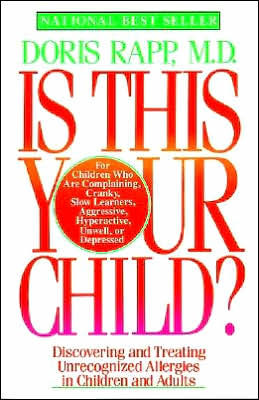Read an Excerpt
Chapter OneHow Many People
Have Allergies?
In 1950, it was thought, about 14 percent of the U.S. population had allergies. The 1985 estimates say that this number may have risen to about 33 percent, or 75 million Americans. All of these figures may be low estimates. For example, physicians interested in environmental medicine estimate that the number of children and adults who have food allergies or sensitivities exceeds 75 percent. They detect and confirm food allergies using short, informative diets and newer variations of traditional allergy skin testing.
If one parent has allergies, one out of every four of his or her offspring will have some form of this problem. If both parents have typical allergies, about 60 percent, or two out of three, of their children will tend to develop allergies. It is most unusual, however, to have more than one exquisitely sensitive child in the same family.
Does Your Child Have Allergies?
Many parents already know that someone in their family is unwell because of hay fever, asthma, hives, or eczema. These are the typical, major accepted forms of allergy.
There are other areas of the body that can be affected by allergies, however. Unfortunately these are not always recognized, suspected, or even agreed upon. Parents may be told repeatedly by their physicians that their children's complaints could not possibly be an allergy. Yet the parents' observations are often entirely valid.
Many adults are totally unaware that some of their children's or their own medical or emotional complaints could be solely due to an allergy. They often attribute chronic congestion,stuffiness, or throat clearing to a chronic sinus problem, but they don't go one step farther to ask why the sinuses are always infected. They attribute their persistent cough to a postnasal drip but never ask why they always have a postnasal drip. Sudden irritability and mood changes, as well as fatigue, are sometimes erroneously attributed solely to the stresses of daily family life or to challenging situations at school or work, when they are in reality unusual manifestations of allergy.
Adopted ChildrenAn inordinate number of allergic children appear to have been adopted. This seems to be particularly true for environmentally ill children. Maybe this is related to the prenatal attitude and health care of the mother. Maybe sometimes the infant cried so much because of an undetected milk allergy that the mother was overwhelmed and placed the infant for adoption. We simply don't know.
What Is an Allergy? Surprisingly there is much confusion at the present time about the definition because the word allergy does not represent the same thing to all physicians. There are two distinctly divergent differences of opinion.
The original definition referred simply to any adverse reaction to a substance that does not bother most other individuals. The majority of people, for example, do not develop illness after they are exposed to dust, molds, pets, freshly cut grass, or after eating certain foods. In contrast allergic individuals commonly develop hay fever, asthma, hives, eczema, or intestinal symptoms from these types of exposures. The tentative diagnosis of allergy was originally based mainly upon the patient's history and physical examination, which suggested allergy. For example, if someone's nose repeatedly and suddenly became watery and itchy while cutting the grass, it was diagnosed as hay fever due to grass pollen.
In 1925, however, allergy was redefined, and the scope of what could be called an allergy became strictly limited. The majority of traditional allergists currently accept three basic concepts in relation to what is or is not an allergy:
- An allergy must affect only specified areas of the body.
- The source of an allergy must be due to established and acceptable causes.
- An allergy must be scientifically confirmed by certain accepted immunological tests.
This restricted definition may have to be updated and liberalized, however. There simply are too many children and adults who do not fit into the current restricted traditional definition of allergy. When too many individuals are the exception, the rules may need to be changed.
Let us examine each concept in a bit of detail.
Areas of the Body That Can Be Affected by Allergy
Many traditional allergy specialists believe that allergies can only affect limited and specific parts of the body. The nose, eyes, lungs, skin, and intestines are accepted areas. They strongly doubt, however, that a slice of bread, for example, could cause a toddler suddenly to be unable to walk or that a peanut butter sandwich could cause a child to fall asleep in school. They would not believe that the brain functions of children could be influenced by a food or other environmental factors, for example dust or mold, in such a way that the children would develop hyperactivity or behavior or learning problems. Articles published over forty years ago, however, as well as recent publications, indicate that a wide variety of medical complaints, including overactivity, fatigue, bed-wetting, inappropriate behavior, and even epilepsy, in some children, may be due to allergies.1 Specialists in environmental medicine believe it is possible that any area of the body can be affected by an allergy or a food or chemical sensitivity. Substances called chemical mediators are released during allergic reactions and travel all over the body, not just to "accepted" areas such as the lungs or nose.
Substances or Exposures That Can Cause Allergy
Traditional allergists believe that only certain specific substances or exposures can cause an allergy. They recognize that dust (mites), molds, pollen, pets, feathers, and a few foods cause hay fever or asthma, but they would strongly doubt that these same items could cause behavior, personality, activity, or learning problems. Most allergists would scoff at the idea that the latter problems or a wide range of typical medical illnesses could be caused by a wide range of foods or by chemical odors.



